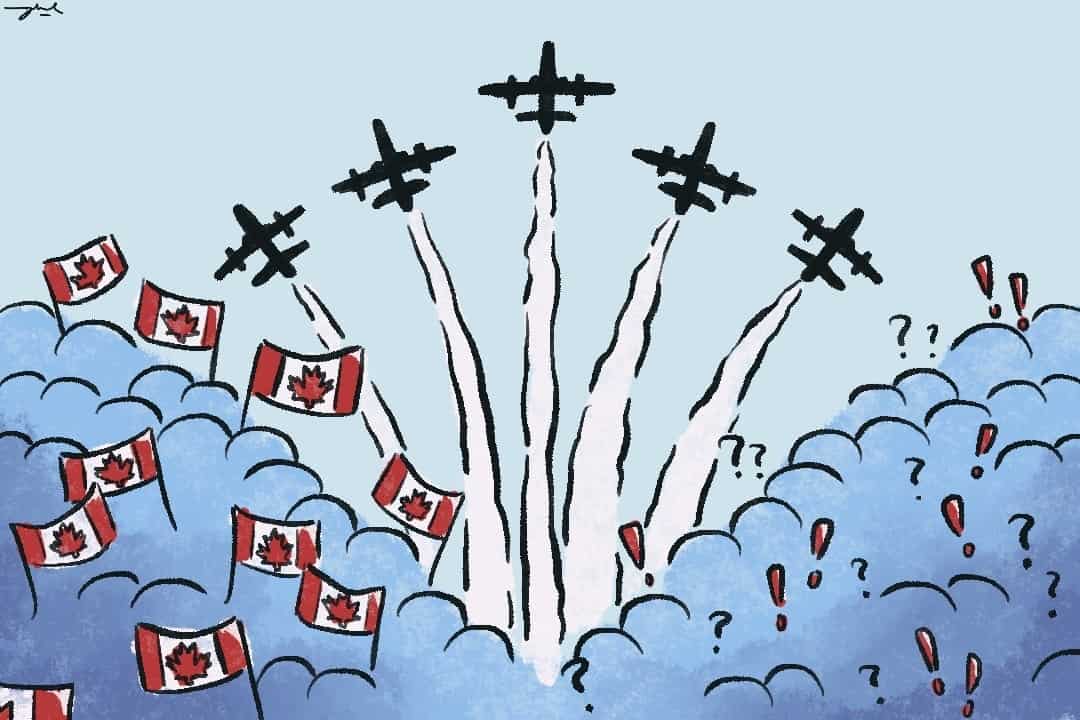For many people, the Canadian International Air Show is a beloved practice that unites generations in honouring their national pride. While I have not seen much discussion on whether the recreational use of warplanes is appropriate amidst Canada’s changing demographics, I feel as if it is almost offensive to broach the subject, lest you be deemed soft, or worse, anti-veteran.
However, the country’s growing refugee population and the associated shift in cultural ideals prompt the following questions. Who is the air show really for? If it’s for Canadians, then what kind of Canadian does the show claim to represent?
It seems unlikely that the display is intended for the benefit of those fleeing from war. It’s no secret that refugees are likely to suffer from trauma, which may have been inflicted by the same planes we see in our Toronto skies over Labour Day weekend.
With that in mind, we should consider what this implies for the lived realities of refugees. Where do those affected by war fit in when it comes to Canada’s military fetishism? It hardly seems like there’s room for the melding of both pro- and anti-war ideologies in our cultural mosaic, no matter how nuanced the mosaic is.
I believe the Air Show’s celebration of military aircraft promotes a culture of war, which is particularly disturbing when nearly a quarter of Canada’s population consists of immigrants as of 2021, and when our nation prides itself on being a provider of global asylum. Instead, the tension between the country’s pacifist ideals and its thinly-veiled militarism indicates a societal disconnect. The Canadian government has no issue adopting vaguely anti-war, pro-peace stances when it’s convenient, as it contributes to its international status as a ‘tolerant’ democracy. However, it has failed to integrate significant anti-imperialist attitudes into cultural promotion.
It’s worth noting that the 2021 Toronto Air Show was sponsored by worldwide weapons manufacturer Lockheed Martin, which proudly flew its F-35 fighter jet over crowds of admiring Torontonians. According to Lockheed Martin’s website, this plane is the “most lethal, survivable, and connected fighter jet in the world,” and is uniquely qualified to offer a “critical advantage” over adversaries.
While this language strategically reinforces notions of homeland defense and global security, the truth is that the F-35 warplane boasts a kill-to-loss exchange ratio of 15:1 — a ratio defined by the number of planes a pilot can expect to lose compared to how many they can expect to kill. The US has also deployed the warplane in both northern Iraq and Syria. Beyond the window dressing, it appears that Canada is happy to rejoice in the mass construction and distribution of weaponry built for the explicit purpose of killing — as long as it’s rebranded as wholesome, family-friendly fun.
In my view, the cognitive dissonance required to embrace multiculturalism while inviting children to marvel at weapons of mass destruction is nothing short of exhausting. It becomes a dark day when Canadians are happy to pat themselves on the back for their openness and acceptance, despite their refusal to adapt to Canada’s changing population.
Of course, we can strike a balance when commemorating our joint histories as Canadians. There’s no doubting the importance of a shared national identity. With that said, I’m not sure that a gratuitous military display reflects the values of a country characterized by its commitment to tolerance and diversity.
I can see these criticisms being met with suggestions that younger generations are less appreciative of what it means to be Canadian, but this couldn’t be further from the truth.
In our increasingly atomized world, we’re in need of a united cultural front now more than ever, but this front must now cater to more than one type of Canadian. I hope that an integrated model of national pride will better reflect the wealth of cultural contexts seen throughout Canada today.
Accounting for the conflicting interests of our shifting population is no easy feat, but the reality is that Canada is home to an estimated 140,621 refugees as of 2022. What’s more is that globally, up to a quarter of refugees have PTSD. The glorification of military aircraft seems to be at odds with Canada’s alleged dedication to welcoming victims of war.
A nation deemed the world leader in the resettlement of refugees should consider how the ways that we honour our heritage risk encroaching on the lives of those seen as “less Canadian.” After all, what good is there in patriotism when it comes at the expense of our most vulnerable citizens? In the end, I believe that we can commend our history of national defense without supporting a state-sanctioned advertisement for military weaponry.
Emma Dobrovnik is a third-year student at St. Michael’s College studying political science and criminology. She is a Director of Mentorship for the Association of Political Science Students and an International Affairs columnist for The Varsity’s Comment section.



No comments to display.